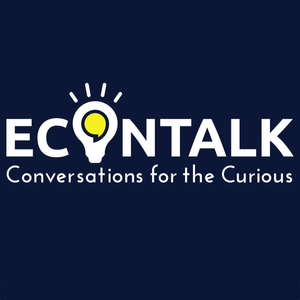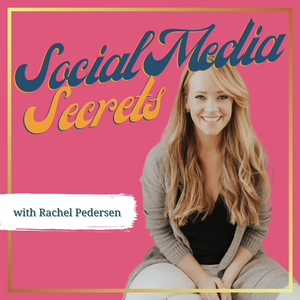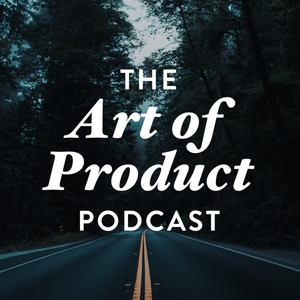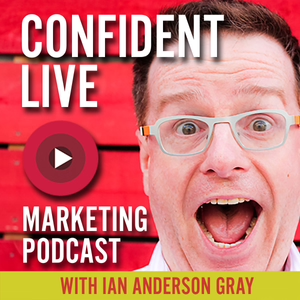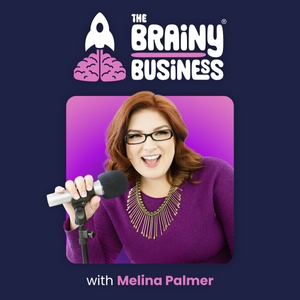
177. How to Successfully Pitch Your Business Using Behavioral Economics
11/05/21 • 31 min
1 Listener
A company's success nowadays is so reliant upon pitching and getting media coverage. Having a credible source say positive things about you and your company can be pivotal when it comes to whether your brand is going to be seen or not.
That is exactly why this episode of The Brainy Business is dedicated to giving you some concise tips on how to use behavioral economics to pitch your brand. I know pitching yourself can feel awkward, but when you understand the brain science it doesn't have to be, especially if you follow my tips!
I discuss different brain biases such as social proof, authority bias, familiarity bias, and really focus on availability bias. Availability bias is critical to pitching success. You can take advantage of it by predicting and paying attention to trends and finding a way to offer people a fresh perspective on them.
We close with three key points to keep in mind when pitching: (1) keep it short (2) be happy with your language and (3) follow directions. This and so much more in this episode, which will help you use behavioral economics to successfully pitch yourself and your business, so listen now...
Show Notes:
- [00:06] In today’s episode, I talk about using brain science to successfully pitch to media.
- [02:22] Pitching yourself can be awkward and uncomfortable, and there are brain biases that can explain why that is. Understanding them can help you turn them around and use them to your advantage.
- [05:05] There is good news – pitching doesn't have to be so hard if you use my tips!
- [07:20] I explain why media coverage and pitching are so important, beginning with social proof.
- [08:43] Authority bias leads us to believing that anything that the news or media reports is true or else it wouldn't be featured.
- [09:32] Familiarity bias makes us lean toward things that we already know or know of.
- [10:26] The final (and I would argue, most important) brain bias that is to your benefit when pitching is availability bias.
- [12:48] One of my favorite examples of availability bias is how travel to Norway drastically increased following the release of Disney's movie Frozen!
- [14:20] In order to take advantage of availability bias, you need to predict trends and offer something unique in relation to them.
- [16:30] Pitching to reporters can be stressful, but remember that reporters are people doing a job. You can be a resource to them they are thankful for if you connect with them properly.
- [19:06] A simple and easy habit you can create to make you a master at pitching by taking advantage of availability bias.
- [21:55] Recognize where you fit and where you can fill in gaps.
- [24:23] Remember to take advantage of familiarity bias! Get people to know who you are and like you before you ask for anything
- [25:41] I recommend signing up for HARO (Help a Reporter Out).
- [27:10] It's important to remember that not all of your pitches will land, but that only makes it that much more rewarding when they do.
- [27:43] I give you some key tips to keep in mind: (1) keep your pitch short and sweet, (2) be sure that you're satisfied with how your pitch is worded, and (3) follow directions that reporters put into their requests and do what they ask.
- [29:30] A quick and simple summary of all the tips in the episode.
- [31:03] Registration is now open for my Setting Brainy Goals course!
Thanks for listening. Don’t forget to subscribe on Apple Podcasts or Android. If you like what you heard, please leave a review on iTunes and share what you liked about the show.
I hope you love everything recommended via The Brainy Business! Everything was independently reviewed and selected by me, Melina Palmer. So you know, as an Amazon Associate I earn from qualifying purchases. That means if you decide to shop from the links on this page (via Amazon or others), The Brainy Business may collect a share of sales or other compensation.Let’s connect:
A company's success nowadays is so reliant upon pitching and getting media coverage. Having a credible source say positive things about you and your company can be pivotal when it comes to whether your brand is going to be seen or not.
That is exactly why this episode of The Brainy Business is dedicated to giving you some concise tips on how to use behavioral economics to pitch your brand. I know pitching yourself can feel awkward, but when you understand the brain science it doesn't have to be, especially if you follow my tips!
I discuss different brain biases such as social proof, authority bias, familiarity bias, and really focus on availability bias. Availability bias is critical to pitching success. You can take advantage of it by predicting and paying attention to trends and finding a way to offer people a fresh perspective on them.
We close with three key points to keep in mind when pitching: (1) keep it short (2) be happy with your language and (3) follow directions. This and so much more in this episode, which will help you use behavioral economics to successfully pitch yourself and your business, so listen now...
Show Notes:
- [00:06] In today’s episode, I talk about using brain science to successfully pitch to media.
- [02:22] Pitching yourself can be awkward and uncomfortable, and there are brain biases that can explain why that is. Understanding them can help you turn them around and use them to your advantage.
- [05:05] There is good news – pitching doesn't have to be so hard if you use my tips!
- [07:20] I explain why media coverage and pitching are so important, beginning with social proof.
- [08:43] Authority bias leads us to believing that anything that the news or media reports is true or else it wouldn't be featured.
- [09:32] Familiarity bias makes us lean toward things that we already know or know of.
- [10:26] The final (and I would argue, most important) brain bias that is to your benefit when pitching is availability bias.
- [12:48] One of my favorite examples of availability bias is how travel to Norway drastically increased following the release of Disney's movie Frozen!
- [14:20] In order to take advantage of availability bias, you need to predict trends and offer something unique in relation to them.
- [16:30] Pitching to reporters can be stressful, but remember that reporters are people doing a job. You can be a resource to them they are thankful for if you connect with them properly.
- [19:06] A simple and easy habit you can create to make you a master at pitching by taking advantage of availability bias.
- [21:55] Recognize where you fit and where you can fill in gaps.
- [24:23] Remember to take advantage of familiarity bias! Get people to know who you are and like you before you ask for anything
- [25:41] I recommend signing up for HARO (Help a Reporter Out).
- [27:10] It's important to remember that not all of your pitches will land, but that only makes it that much more rewarding when they do.
- [27:43] I give you some key tips to keep in mind: (1) keep your pitch short and sweet, (2) be sure that you're satisfied with how your pitch is worded, and (3) follow directions that reporters put into their requests and do what they ask.
- [29:30] A quick and simple summary of all the tips in the episode.
- [31:03] Registration is now open for my Setting Brainy Goals course!
Thanks for listening. Don’t forget to subscribe on Apple Podcasts or Android. If you like what you heard, please leave a review on iTunes and share what you liked about the show.
I hope you love everything recommended via The Brainy Business! Everything was independently reviewed and selected by me, Melina Palmer. So you know, as an Amazon Associate I earn from qualifying purchases. That means if you decide to shop from the links on this page (via Amazon or others), The Brainy Business may collect a share of sales or other compensation.Let’s connect:
Previous Episode

176. Reframing Annoying Disruptions to Support Innovation, with Adam Hansen, coauthor of Outsmart Your Instincts
Have you ever had a disruption in your routine – moving to a new house, taking a new route to work – and found yourself exhausted every day?
This is common when our habits are upended (the subconscious can’t use its rules anymore so your conscious is having to do a lot more work!). And while it may feel annoying, this is also a great opportunity to innovate and change your life for the better.
Today, I’m joined by Adam Hansen, VP of behavioral innovation at Ideas To Go and coauthor of Outsmart Your Instincts who happened to be in the midst of a move, so we talk about how to reframe an annoying disruption in habits to make it work for you. We also discuss the curse of knowledge and how it impacts businesses, risks of omission versus risks of commission, and other fun behavioral goodness sprinkled throughout (including my new favorite term of being an “omnivore of information”). Listen now...
Show Notes:
- [00:07] In today’s episode, I’m excited to introduce you to Adam Hansen, VP of behavioral innovation at Ideas To Go and coauthor of Outsmart Your Instincts.
- [03:18] Adam shares about himself and his background. He always knew that innovation would be part of his career.
- [05:18] When working on the book, they started looking at all the cognitive biases to figure out which ones were causing most of the mayhem in innovation.
- [06:16] If you adopt the behavioral innovation approach, you can see three to four times improvement in performance and quality of ideas very early on in innovation. You can get to better ideas faster.
- [09:01] All of the thousands of small decisions we make every day that have been automated are lost when you move. Each little thing is so minor that we don’t realize what the cumulative effect of all those small decisions is.
- [10:02] It is important for us to automate everything we can.
- [12:19] It is impossible for us to place ourselves fully back in the shoes of our first-time clients. Our version of dumbing things down to meet them where they are is still going to be more advanced than where we need to get to. We can work on this by following up with first-time clients and asking what you could have done better.
- [13:46] There is so much more jargon in your business than you think there is.
- [16:10] Our need for tangibility is much greater than we assume. Most people need help to break down abstraction. The more tangible you can be the better.
- [18:13] The curse of knowledge is the idea that once you become knowledgeable in a given area, you can't unknow what you know and you can’t fully place yourself back in the shoes of the subject.
- [23:27] Negativity Bias is the idea from our ancestors of thinking of all novelty as threat and not opportunity.
- [25:12] Especially in innovation, we need to be as opportunity minded as possible. We need to be aware of threats and take smart action to minimize and mitigate those threats.
- [27:43] When we are in moments of threat, to still be able to take swift decisive action is fantastic (and sometimes life-saving!)
- [28:29] The research shows that negativity can appear super profound. Too often we are shooting down ideas and not coming up with alternatives. That is not progress.
- [30:31] We are predisposed to go toward the negative any time a new idea comes up.
- [31:38] The more you can value ideas early on for their provocative value rather than for their immediate merits the better. Then you are in a better frame of mind to take on the negatives.
- [33:54] When you approach challenges to problems in this way, there is real value. The language is brilliant, priming to get people to deal with problems and concerns in a much better way.
- [35:10] If you are an optimistic person it doesn’t mean that you don’t have a negativity bias and pessimistic people still have optimism bias.
- [36:44] Go in understanding that there will be some differences and then the task becomes “How do we get the most out of the differences?” The more you can approach differences with curiosity than defensiveness...the better.
- [37:48] Curiosity is very smart and super adaptive. Be curious even when it is hard to be curious.
- [39:07] Curiosity kills the cat, satisfaction brought it back. (Did you know there was more to that saying?!)
- [41:49] It is hard to gather data on what you don’t do.
- [43:42] Every year to 18 months every person should “fire themselves.” If you fire yourself and come into your job as if you had new eyes...what would you do differently? When you start a new job you are looking for all these opportunities of growth and then you become stagnant.
- [45:07] We need to be more intentional and realize we can choose better becaus...
Next Episode

178. The Power of Us with Dr. Dominic Packer
It’s November – a month where many begin to reflect on the year and (at least here in the states) consider the things we are thankful for. It kicks off the holiday season and we may begin to think about those around us whom we may see in person or virtually this holiday. Because of that, it seemed like the perfect time to discuss The Power of Us, a new book from coauthors Dr. Jay Van Bavel and Dr. Dominic Packer.
Today, Dr. Dominic Packer is here to talk about this fantastic book and their years of research together. The insights in the book come together to help people harness their shared identities to improve performance, increase cooperation and promote social harmony. I’m guessing you can see why I chose to have this episode come out now, even though it is a couple of months after we recorded and when the book was officially released. It just seemed like the perfect time to share and help everyone to reflect upon the power of “us.” Listen to the episode now to see how this can be leveraged in your life and business...
Show Notes:- [00:07] In today’s episode I’m excited to introduce you to Dr. Dominic Packer, coauthor of The Power of Us.
- [03:10] Dominic shares about himself and his background. He is a social psychologist and professor.
- [06:01] The book is about group identities. The groups we belong to can become part of who we are.
- [06:56] When we take on a group identity, we are very likely to be influenced by the norms of that group.
- [07:59] There is a second kind of influence which is informational influence. We look to other people to see what is a sensible thing to do. The norms through those groups become a way we express those identities.
- [09:36] Dominic shares about the 20 statements task.
- [11:22] For many of us, some really key aspects of ourselves come from these groups. They drive a lot of the way we think of the world, the emotions we feel, and the decisions we end up making.
- [13:02] During the course of a single day different aspects of a single person’s identity will come in and out of focus. Our behaviors are not exactly the same at different parts of the day when we operate through these different identities.
- [14:52] One of the fascinating things about identity is that it is flexible, malleable, and adaptive to current circumstances.
- [17:08] Group-based divisions might arise by politics, fights over resources, or major political differences.
- [18:26] Groups are a tremendously useful tool for human beings. They are fundamental to our survival. Humans have succeeded by getting together.
- [21:35] In many corporate situations you have different divisions and units and people confirm identities at that subgroup level. People can get a lot of sense of connection and be very motivated to do well on behalf of their subgroup.
- [22:25] Identities are often multi-leveled. If you shift their focus from their lower-level identity to their higher level and especially if you create conditions where they need to work together it can bring them together.
- [23:50] You need to create the conditions by which people can see themselves as part of something larger than their immediate sub-group. People need to see that there is an organizational identity.
- [25:11] We need to incentivize collective identity instead of individual identities. Setting universal goals can also help.
- [28:07] “Dissent is quite hard and people only do it because they care deeply about a group.”
- [29:59] Both the people who are the most likely to conform to group norms most of the time are also the most likely to dissent when they see something as problematic or needing change in their group. This is because they care a lot.
- [30:50] To speak out is to take a risk and to take that risk is that you need to have some level of identification and care about the group.
- [32:24] You do want a culture where the people that are strongly identified with the group do feel like they can speak up when they see something as problematic or see something that has the possibility of change or improvement.
- [32:53] A psychologically safe environment is one where people feel comfortable speaking up and speaking out, being critical, and being divergent. They feel comfortable because they know it will be okay.
- [34:03] You want an organization where your people are identified and they really value the collective goals but they are engaging with them creatively.
- [35:24] If you are trying to cultivate a group where people can share their ideas and can have better ideas than you, it is really important that you don’t squash them even when they are not good ideas.
- [36:49] As a boss, take time to reflect on what you are good at. Validating yourself and the contributions you make to free you up to be less threat...
If you like this episode you’ll love
Episode Comments
Generate a badge
Get a badge for your website that links back to this episode
<a href="https://goodpods.com/podcasts/the-brainy-business-understanding-the-psychology-of-why-people-buy-beh-136281/177-how-to-successfully-pitch-your-business-using-behavioral-economics-17391584"> <img src="https://storage.googleapis.com/goodpods-images-bucket/badges/generic-badge-1.svg" alt="listen to 177. how to successfully pitch your business using behavioral economics on goodpods" style="width: 225px" /> </a>
Copy
